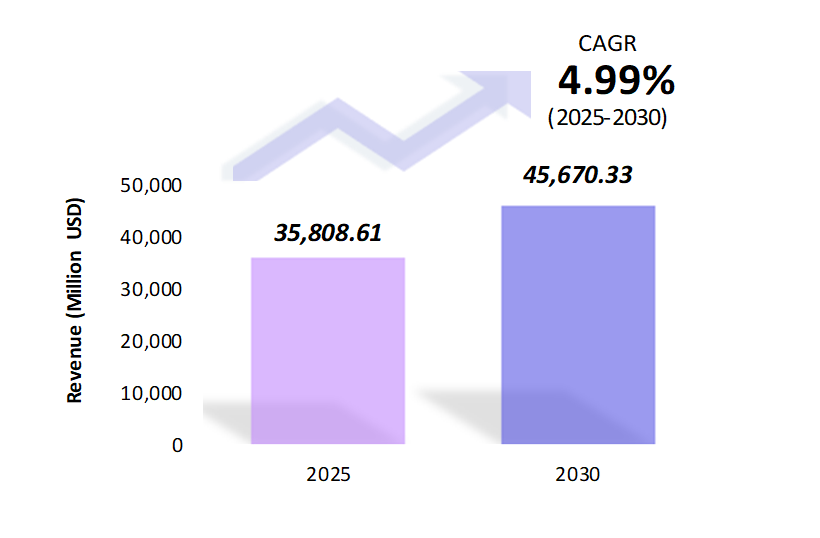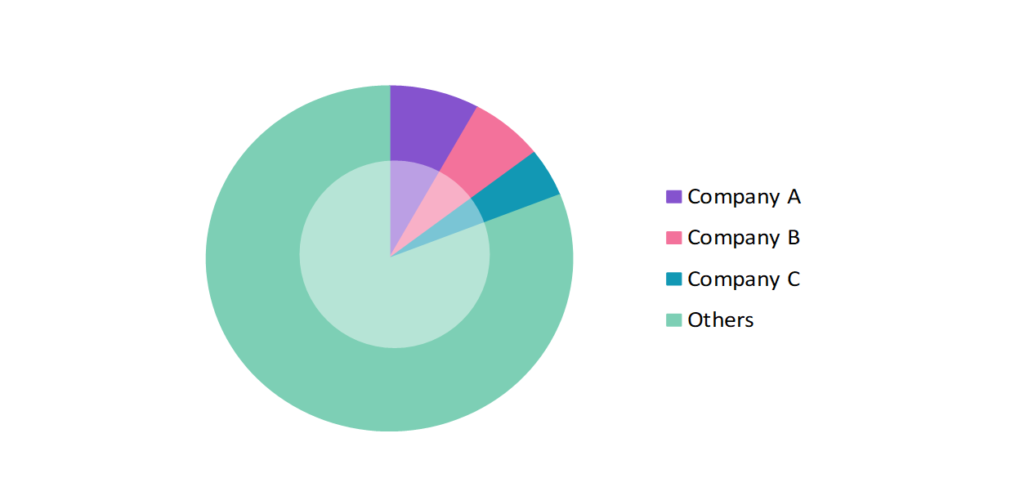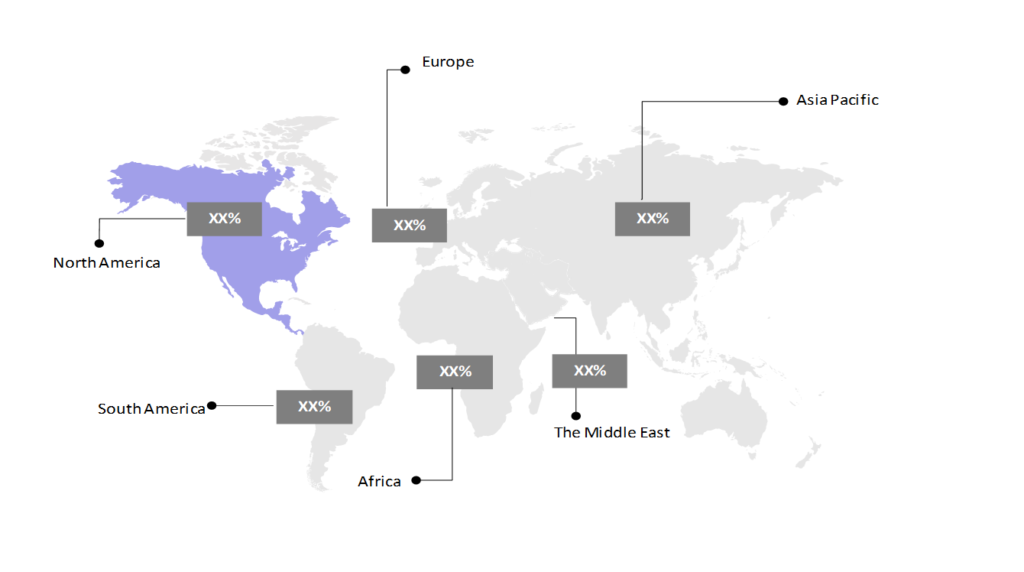Frozen Seafood Market Insights: Size, Share, Growth Analysis & Forecast (2024-2029)
The market report provided a comprehensive analysis segmented by Type (Fish, Crustacean, Mollusk, Others); by End Use (Food Processing Industry, Food Service, Retail/Household); by Geography (North America, South America, Asia Pacific, Europe, The Middle East, Africa).
Outlook

- The frozen seafood market is estimated to be at USD 35,808.61 Mn in 2025 and is anticipated to reach USD 45,670.33 Mn in 2030.
- The frozen seafood market is registering a CAGR of 4.99% during the forecast period 2025-2030.
- The frozen seafood market is experiencing robust growth fueled by consumer demand for convenient, healthy, and sustainable food options. Technological innovations in freezing and packaging have enhanced product quality, which extended shelf life and improved freshness. The expansion of online retail has increased accessibility. Overall, the market is adapting to changing preferences and innovations, positioning itself for continued expansion.
Request a free sample.
Ecosystem

- The participants in the global frozen seafood industry are always developing their strategies to preserve a competitive advantage.
- Companies are increasingly focusing on product innovation to differentiate themselves in a competitive market. This includes developing ready-to-cook meals, plant-based seafood alternatives, and sustainable seafood options.
- Several important entities in the frozen seafood market include Nueva Pescanova, S.L.; Thai Union Group Co., Ltd.; Austevoll Seafood ASA; Lerøy Seafood Group ASA; The Pacific Seafood Group; and others.
Ask for customization.
Findings
| Attributes | Values |
|---|---|
| Historical Period | 2019-2023 |
| Base Year | 2024 |
| Forecast Period | 2025-2030 |
| Market Size (2025) | USD 35,808.61 Mn |
| Market Size (2030) | USD 45,670.33 Mn |
| Growth Rate | 4.99% CAGR from 2025 to 2030 |
| Key Segments | Type (Fish, Crustacean, Mollusk, Others); End Use (Food Processing Industry, Food Service, Retail/Household); Geography (North America, South America, Asia Pacific, Europe, The Middle East, Africa) |
| Key Vendors | Nueva Pescanova, S.L.; Thai Union Group Co., Ltd.; Austevoll Seafood ASA; Lerøy Seafood Group ASA; The Pacific Seafood Group |
| Key Countries | The US; Canada; Mexico; Brazil; Argentina; Colombia; China; Japan; Vietnam; South Korea; Norway; Russia; Netherlands; Spain; Turkey; Israel; Oman; Namibia, Nigeria; South Africa |
| Largest Market | North America |
Get a free quote.
Trends
- Use of Spiral Freezers with Horizontal Airflow: This advanced freezing technology is a key innovation that enhances the preservation of frozen seafood. Spiral freezers utilize horizontal airflow and provide uniform and consistent freezing, which preserves the natural texture and flavor of seafood. Additionally, these freezers enhance production efficiency by automating the freezing process, which minimizes manual handling and enables continuous operation.
- Innovative Packaging Solutions: Packaging plays a vital role in extending the shelf life of frozen seafood while maintaining its quality. Improved packaging techniques, such as vacuum-sealed bags and modified atmosphere packaging (MAP), reduce exposure to air and moisture, which helps prevent freezer burn and nutrient loss. These methods also minimize environmental impact by using eco-friendly materials.
- Rising Popularity of Ready-to-Cook Seafood: Busy lifestyles and demand for convenience have boosted the popularity of ready-to-cook and pre-packaged frozen seafood options. Products like frozen shrimp, fillets, and seafood medleys that require minimal preparation are becoming staple items in households, especially in urban markets.
Speak to analyst.
Catalysts
- Increased Demand for Convenience: Busy lifestyles are driving the demand for ready-to-cook and easy-to-prepare frozen seafood options. Products like Yeam Seng’s “8-Minute Fish Steak,” designed to be cooked quickly using devices like air fryers or microwaves, are targeted at working professionals and families seeking quick meal solutions. This addresses the consumer’s need for nutritious meals without extensive preparation time.
- Sustainability and Ethical Sourcing: Environmental concerns and overfishing are prompting consumers to choose sustainably sourced seafood, which is driving growth in responsibly managed fisheries and aquaculture. Certifications such as MSC (Marine Stewardship Council) and innovations in plant-based seafood alternatives, like Good Catch’s fish-free products, cater to eco-conscious consumers. These innovations support ocean conservation efforts while providing seafood-like experiences.
- Growth of E-Commerce and Online Retail: The rise of online retail platforms, particularly after the COVID-19 pandemic, has transformed the way consumers purchase frozen seafood. Companies are focusing on direct-to-consumer models and enhancing cold chain logistics to ensure the quality of products during delivery. For instance, seafood brand Pescafresh has expanded their digital presence, which allows consumers to order premium frozen seafood online and have it delivered fresh to their doorsteps.
Inquire before buying.
Restraints
- Fluctuating Seafood Prices: One significant challenge faced by the frozen seafood industry is the volatility of seafood prices. This fluctuation is directed by several factors, including climate change, which impacts fish populations and disrupts fishing activities, and overfishing, which reduces available stocks and drives up prices. In addition, geopolitical tensions, such as territorial disputes in fishing waters, can limit access to certain seafood resources, further contributing to price instability.
- Consumer Perception of Frozen vs. Fresh: Despite advances in freezing technology that preserve the quality of seafood, many consumers still perceive frozen seafood as inferior to fresh options. Overcoming this misconception requires greater consumer education and marketing to highlight the benefits of frozen seafood, such as longer shelf life, convenience, and minimizing food waste.
- Regulatory and Compliance Issues: The frozen seafood industry must comply with strict health and safety standards, particularly for international trade. Different countries have varied regulations regarding food safety, labeling, and packaging, which can complicate export strategies and increase operational costs. For example, companies need Food and Drug Administration (FDA) approval to enter the US market, which can be a lengthy process.
Personalize this research.
Hotspot

Explore purchase options.
Table of Contents
| 1. Introduction 1.1. Research Methodology 1.2. Scope of the Study 2. Market Overview / Executive Summary 2.1. Global Frozen Seafood Market (2019 – 2023) 2.2. Global Frozen Seafood Market (2024 – 2030) 3. Market Segmentation 3.1. Global Frozen Seafood Market by Type 3.1.1. Fish 3.1.2. Crustacean 3.1.3. Mollusk 3.1.4. Others 3.2. Global Frozen Seafood Market by End Use 3.2.1. Food Processing Industry 3.2.2. Food Service 3.2.3. Retail/Household 4. Regional Segmentation 4.1. North America 4.1.1. The US 4.1.2. Canada 4.1.3. Mexico 4.2. South America 4.2.1. Brazil 4.2.2. Argentina 4.2.3. Colombia 4.2.4. Rest of South America 4.3. Asia Pacific 4.3.1. China 4.3.2. Japan 4.3.3. Vietnam 4.3.4. South Korea 4.3.6. Rest of Asia Pacific 4.4. Europe 4.4.1. Norway 4.4.2. Russia 4.4.3. Netherlands 4.4.4. Spain 4.4.5. Rest of Europe 4.5. The Middle East 4.5.1. Turkey 4.5.2. Israel 4.5.3. Oman 4.5.4. Rest of Middle East 4.6. Africa 4.6.1. Namibia 4.6.2. Nigeria 4.6.3. South Africa 4.6.4. Rest of Africa 5. Value Chain Analysis of the Global Frozen Seafood Market 6. Porter Five Forces Analysis 6.1. Threats of New Entrants 6.2. Threats of Substitutes 6.3. Bargaining Power of Buyers 6.4. Bargaining Power of Suppliers 6.5. Competition in the Industry 7. Trends, Drivers and Challenges Analysis 7.1. Market Trends 7.1.1. Market Trend 1 7.1.2. Market Trend 2 7.1.3. Market Trend 3 7.2. Market Drivers 7.2.1. Market Driver 1 7.2.2. Market Driver 2 7.2.3. Market Driver 3 7.3. Market Challenges 7.3.1. Market Challenge 1 7.3.2. Market Challenge 2 7.3.3. Market Challenge 3 8. Opportunities Analysis 8.1. Market Opportunity 1 8.2. Market Opportunity 2 8.3. Market Opportunity 3 9. Competitive Landscape 9.1. Nueva Pescanova, S.L. 9.2. Thai Union Group Co., Ltd. 9.3. Austevoll Seafood ASA 9.4. Lerøy Seafood Group ASA 9.5. The Pacific Seafood Group 9.6. Company 6 9.7. Company 7 9.8. Company 8 9.9. Company 9 9.10. Company 10 |
Know the research methodology.
Frozen Seafood Market – FAQs
1. What is the current size of the frozen seafood market?
Ans. In 2025, the frozen seafood market size is USD 35,808.61 Mn.
2. Who are the major vendors in the frozen seafood market?
Ans. The major vendors in the frozen seafood market are Nueva Pescanova, S.L.; Thai Union Group Co., Ltd.; Austevoll Seafood ASA; Lerøy Seafood Group ASA; The Pacific Seafood Group.
3. Which segments are covered under the frozen seafood market segments analysis?
Ans. The frozen seafood market report offers in-depth insights into Type, End Use, and Geography.
